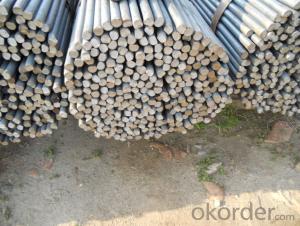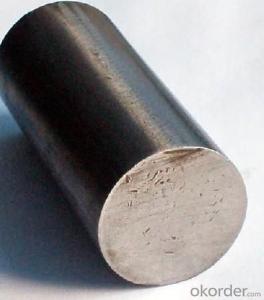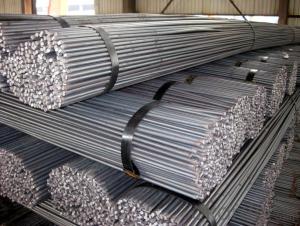Round bar Q235 ou Q195 5MM-100MM hot rolled
- Loading Port:
- Shanghai
- Payment Terms:
- TT OR LC
- Min Order Qty:
- 25 m.t.
- Supply Capability:
- 20000 m.t./month
OKorder Service Pledge
OKorder Financial Service
You Might Also Like
ROUND BAR Details:
| Minimum Order Quantity: | Unit: | m.t. | Loading Port: | ||
| Supply Ability: | Payment Terms: | Package: | wire bundle |
Product Description:
Specifications of Wire Rod Q235:
Steel Grade: Q235, Standard: GB Diameter: 5.5mm, 6.5mm, 7mm,8mm,9mm,10mm,12mm,14mm
Diameter Tolerance:±0.3mm 6.5mm can be drawing into 2mm/8.0mm can be drawing into 3mm
Brand Name: N-RIVER Place of Origin: Hebei, China Mainland Application: construction, building etc
Chemical Composition:
Please kindly find our chemistry of our material based on Q235 as below for your information
Trademark | Rank | Chemical composition (quality score) % | |||||
C | Si | Mn | S | P | |||
| ≤ |
| ≤ | ≤ | |||
Q235 | A | 0.14-0.22 | 0.30 | 0.30-0.65 | 0.050 | 0.045 | |
Q235 | B | 0.12-0.20 | 0.30 | 0.30-0.70 | 0.045 | 0.045 | |
Trademark | Rank | Pulling Test | |||||
Bend PointΔs/Mpa | Tensile Strength | Elongation Ratioδ5% | |||||
Thickness (Diameter) /MM | Thickness (Diameter) /MM | ||||||
≤16 | 16-40 | ≤16 | 16-40 | ||||
≥ | ≥ | ||||||
Q235 | A | 235 | 225 | 375-500 | 26 | 25 | |
Q235 | B | 235 | 225 | 375-500 | 26 | 25 | |
Usage and Applications of Wire Rod Q235:
After hot-rolled the products shaped into coil and delivery as finished product, including round, square, rectangular, hexagonal and so on. Since most of the products are round, it is generally called wire rod. Carbon steel wire rod is widely used in construction and manufacturing. Carbon steel wire rod is mainly used for reinforcement of reinforced concrete and welded structure or reprocessed (roberts , nail, etc.) materials, especially used to produce wire drawing, welding electrode, nails, spring, electronic, precise machinery parts and so on.
Packaging & Delivery of Wire Rod Q235:
Packaging Detail: products are packed in coil and then shipped by container or bulk vessel
Each coil weight: 2-3MT
Delivery Detail: within 45 days after received deposit or LC.
Label: to be specified by customer, generally, each bundle has 1-2 labels
Trade terms: FOB, CFR, CIF
- Q:Can steel round bars be used for construction purposes?
- Yes, steel round bars can be used for construction purposes. Steel round bars are commonly used in construction for various applications such as reinforcement in concrete structures, as support for beams and columns, and as structural components in bridges, buildings, and infrastructure projects. The high tensile strength and durability of steel make it an ideal choice for construction purposes, as it can withstand heavy loads, provide stability, and ensure the longevity and safety of the structures. Additionally, steel round bars are versatile and can be easily fabricated and customized to meet specific project requirements. Therefore, steel round bars are widely used in the construction industry due to their excellent mechanical properties, reliability, and cost-effectiveness.
- Q:How do steel round bars compare to fiberglass round bars?
- Steel round bars and fiberglass round bars have different properties and characteristics, making them suitable for different applications. Steel round bars are known for their high strength and durability, making them ideal for heavy-duty applications such as construction, machinery, and automotive industries. They have a higher tensile strength and can withstand more stress and load compared to fiberglass round bars. On the other hand, fiberglass round bars are lighter in weight, have excellent corrosion resistance, and are non-conductive, making them suitable for applications that require electrical insulation or resistance to chemicals. Ultimately, the choice between steel and fiberglass round bars depends on the specific requirements of the project or application.
- Q:What is the maximum weight capacity of a steel round bar?
- The maximum weight a steel round bar can hold depends on several factors, including its diameter, length, grade, and type of steel. Steel round bars are available in various sizes and grades, each with its own load-bearing capacity. To determine the maximum weight a steel round bar can handle, you need to calculate its cross-sectional area using the formula: Area = π * (diameter/2)^2. Here, π represents a mathematical constant that is approximately equal to 3.14159. Once you have the cross-sectional area, you can estimate the weight of the bar by multiplying it with the density of the specific steel grade. The density of steel varies based on the grade, but as a general approximation, it is around 7850 kilograms per cubic meter (or 0.00785 grams per millimeter cubed). However, it's important to remember that weight capacity alone may not be the only factor to consider for the safe use of a steel round bar. Other factors like load distribution, applied forces, and the structural integrity of the bar are equally important to ensure safe operation. For accurate weight capacity information for a specific steel round bar, it is recommended to refer to the manufacturer's specifications or consult a qualified engineer or professional who can provide precise calculations based on the specific requirements and characteristics of the steel round bar in question.
- Q:What is the difference between a solid steel round bar and a hollow steel round bar?
- A solid steel round bar is a cylindrical metal rod with a consistent diameter along its entire length. It is made of solid steel and does not have any empty space inside. On the other hand, a hollow steel round bar also has a cylindrical shape but contains an empty space within its center. The size of this empty space can vary depending on the design and purpose of the bar. The main difference between the two lies in their structural integrity and weight-bearing capacity. A solid steel round bar offers greater strength and stability compared to a hollow steel round bar. This is because the solid bar is made of continuous steel material, making it more resistant to pressure-induced bending, twisting, or deformations. It is commonly used in industries that require high strength and durability, such as construction, engineering, and manufacturing. In contrast, a hollow steel round bar may have reduced strength and load-bearing capacity due to the empty space inside. However, the hollow design provides certain benefits in terms of weight, cost, and flexibility. The hollow space reduces the overall weight of the bar, making it suitable for applications where weight is a critical factor, such as aerospace or automotive industries. Moreover, the hollow space can be utilized for various purposes, such as passing electrical wires or fluids, providing ventilation, or reducing material costs by using less steel. Ultimately, the choice between a solid steel round bar and a hollow steel round bar depends on the specific requirements of the application. If strength and stability are crucial, a solid bar is the preferred choice. In contrast, if weight reduction, cost-efficiency, or additional functionality is desired, a hollow bar may be more suitable.
- Q:How do steel round bars compare to titanium round bars?
- Steel round bars and titanium round bars have distinct properties and are used for different purposes. Steel round bars are known for their high strength, durability, and affordability. They are commonly used in construction, manufacturing, and general engineering applications. On the other hand, titanium round bars are much lighter, have superior corrosion resistance, and exhibit high strength-to-weight ratio. This makes them suitable for aerospace, medical, and marine industries where weight reduction and resistance to harsh environments are crucial. Ultimately, the choice between steel and titanium round bars depends on the specific requirements and desired characteristics for the intended application.
- Q:What are the different types of steel round bar surface finishes?
- Steel round bars can be treated with various surface finishes to meet different needs. Some of the most commonly used finishes are: 1. Bright: By polishing the steel round bar, a shiny and reflective surface is achieved. This finish is often employed for decorative purposes or when aesthetics are important. 2. Grinded: To achieve a smooth and even surface, the outer layer of the steel round bar is removed using a grinding wheel or abrasive belt. This finish is useful for eliminating imperfections or creating a uniform surface for further processing. 3. Brushed: Fine lines are created on the surface of the steel round bar using a wire brush or abrasive pad. This finish is preferred for its unique aesthetic appeal and is commonly used in architectural applications. 4. Powder-coated: Dry powder is applied to the surface of the steel round bar and then cured using heat. This finish provides a durable and corrosion-resistant coating that can be applied in various colors and textures. 5. Galvanized: A protective zinc coating is applied to the steel round bar to prevent corrosion. This finish is commonly used in outdoor or marine applications where the steel is exposed to moisture or harsh environmental conditions. 6. Oiled: A thin layer of oil is applied to the surface of the steel round bar. This finish offers temporary protection against corrosion and is often used for short-term storage or transportation purposes. 7. Shot-blasted: Small metallic or non-metallic particles are propelled at high speeds onto the surface of the steel round bar. This process creates a textured finish that improves the adhesion of subsequent coatings or paints. Each type of surface finish has its own unique advantages and is selected based on the specific requirements of the application.
- Q:What are the different types of steel round bars used in the manufacturing of bearings?
- There are several types of steel round bars that are commonly used in the manufacturing of bearings. These include: 1. Carbon steel round bars: They are durable and have good hardness, making them suitable for general-purpose bearings. 2. Chrome steel round bars: These bars have a higher hardness and better wear resistance, making them ideal for high-load and high-speed applications. 3. Stainless steel round bars: They provide excellent corrosion resistance and are commonly used in bearings for corrosive environments or food-grade applications. 4. Tool steel round bars: These bars have superior toughness and wear resistance, making them suitable for heavy-duty and high-temperature applications. Overall, the choice of steel round bar depends on the specific requirements and operating conditions of the bearings.
- Q:How do I determine the load capacity of a steel round bar?
- To ascertain the load capacity of a steel round bar, one must take into account a range of factors. The load capacity of said round bar is contingent upon its diameter, length, and the specific steel variant employed. The ensuing steps elucidate the process of determining the load capacity: 1. Ascertain the steel grade: Distinct steel grades exhibit distinct strength properties. A few examples of common steel grades are A36, A572, and 4140. To pinpoint the precise grade of the steel round bar at hand, reference the specifications or seek guidance from an engineer. 2. Calculate the cross-sectional area: Employ the formula A = πr² to compute the cross-sectional area of the round bar, with A representing the area and r representing the radius of said bar. Remember to convert the diameter to radius by dividing it by 2. 3. Determine the allowable stress: The allowable stress denotes the maximum stress that a material can endure prior to deformation or failure. This value can be gleaned from engineering handbooks or through consultation with an engineer. 4. Apply the load capacity formula: Compute the load capacity of the round bar using the formula Load Capacity = Allowable Stress × Cross-sectional Area. 5. Account for safety factors: In engineering applications, it is customary to incorporate safety factors to ensure the safety of the structure. The specific safety factors hinge upon the application in question and the desired level of reliability. To ascertain the ultimate load capacity, reference the appropriate safety factor for your project. It is crucial to acknowledge that calculating the load capacity of a steel round bar is a multifaceted procedure necessitating expertise in structural engineering. If any uncertainty arises or precise calculations are required, it is advisable to seek the guidance of a qualified engineer who can furnish detailed analysis predicated on the specific parameters of your project.
- Q:Can steel round bars be used for making interior components?
- Yes, steel round bars can be used for making interior components. They are often used in various applications such as handrails, furniture, fixtures, and decorative elements due to their strength, durability, and versatility.
- Q:Can steel round bars be used for making stabilizer bars?
- Yes, steel round bars can be used for making stabilizer bars. Steel round bars are commonly used in various industries, including automotive, for their high strength and durability. Stabilizer bars require materials that can withstand heavy loads and provide stability, making steel round bars an ideal choice for their construction.
1. Manufacturer Overview |
|
|---|---|
| Location | |
| Year Established | |
| Annual Output Value | |
| Main Markets | |
| Company Certifications | |
2. Manufacturer Certificates |
|
|---|---|
| a) Certification Name | |
| Range | |
| Reference | |
| Validity Period | |
3. Manufacturer Capability |
|
|---|---|
| a)Trade Capacity | |
| Nearest Port | |
| Export Percentage | |
| No.of Employees in Trade Department | |
| Language Spoken: | |
| b)Factory Information | |
| Factory Size: | |
| No. of Production Lines | |
| Contract Manufacturing | |
| Product Price Range | |
Send your message to us
Round bar Q235 ou Q195 5MM-100MM hot rolled
- Loading Port:
- Shanghai
- Payment Terms:
- TT OR LC
- Min Order Qty:
- 25 m.t.
- Supply Capability:
- 20000 m.t./month
OKorder Service Pledge
OKorder Financial Service
Similar products
New products
Hot products
Related keywords































